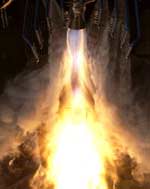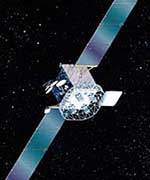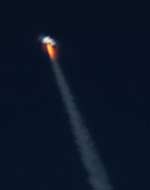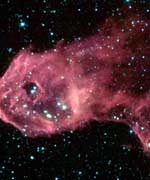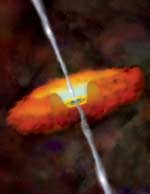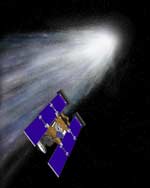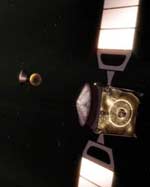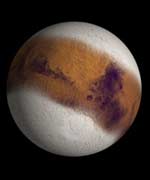
Image credit: NASA/JPL
Data gathered by NASA’s Mars Global Surveyor and Mars Odyssey spacecraft show evidence that the Red Planet might be coming out of a recent ice age. Unlike on Earth, an ice age on Mars happens when the poles warm up and water vapour can escape to lower latitudes on the planet. Scientists examined global patterns of landscape shapes and near-surface ice levels and found that a covering of ice and dust covered the surface to latitudes as low as 30 degrees – and it’s currently on the retreat. They believe this ice age happened just 400,000 to 2.1 million years ago.
NASA’s Mars Global Surveyor and Mars Odyssey missions have provided evidence of a relatively recent ice age on Mars. In contrast to Earth’s ice ages, a Martian ice age waxes when the poles warm, and water vapor is transported toward lower latitudes. Martian ice ages wane when the poles cool and lock water into polar icecaps.
The “pacemakers” of ice ages on Mars appear to be much more extreme than the comparable drivers of climate change on Earth. Variations in the planet’s orbit and tilt produce remarkable changes in the distribution of water ice from Polar Regions down to latitudes equivalent to Houston or Egypt. Researchers, using NASA spacecraft data and analogies to Earth’s Antarctic Dry Valleys, report their findings in Thursday’s edition of the journal Nature.
“Of all the solar system planets, Mars has the climate most like that of Earth. Both are sensitive to small changes in orbital parameters,” said planetary scientist Dr. James Head of Brown University, Providence, R.I., lead author of the study. “Now we’re seeing that Mars, like Earth, is in a period between ice ages,” he said.
Discoveries on Mars, since 1999, of relatively recent water- carved gullies, glacier-like flows, regional buried ice and possible snow packs created excitement among scientists who study Earth and other planets. Information from the Mars Global Surveyor and Odyssey missions provided more evidence of an icy recent past.
Head and co-authors from Brown (Drs. John Mustard and Ralph Milliken), Boston University (Dr. David Marchant) and Kharkov National University, Ukraine (Dr. Mikhail Kreslavsky) examined global patterns of landscape shapes and near-surface water ice the orbiters mapped. They concluded a covering of water ice mixed with dust mantled the surface of Mars to latitudes as low as 30 degrees, and is degrading and retreating. By observing the small number of impact craters in those features and by backtracking the known patterns of changes in Mars’ orbit and tilt, they estimated the most recent ice age occurred just 400 thousand to 2.1 million years ago, very recent in geological terms. “These results show Mars is not a dead planet, but it undergoes climate changes that are even more pronounced than on Earth,” Head said.
Marchant, a glacial geologist, who spent 17 field seasons in the Mars-like Antarctic Dry Valleys, said, “These extreme changes on Mars provide perspective for interpreting what we see on Earth. Landforms on Mars that appear to be related to climate changes help us calibrate and understand similar landforms on Earth. Furthermore, the range of microenvironments in the Antarctic Dry Valleys helps us read the Mars record.”
Mustard said, “The extreme climate changes on Mars are providing us with predictions we can test with upcoming Mars missions, such as Europe’s Mars Express and NASA’s Mars Exploration Rovers. Among the climate changes that occurred during these extremes is warming of the poles and partial melting of water at high altitudes. This clearly broadens the environments in which life might occur on Mars.”
According to the researchers, during a Martian ice age, polar warming drives water vapor from polar ice into the atmosphere. The water comes back to ground at lower latitudes as deposits of frost or snow mixed generously with dust. This ice-rich mantle, a few meters thick, smoothes the contours of the land. It locally develops a bumpy texture at human scales, resembling the surface of a basketball, and also seen in some Antarctic icy terrains. When ice at the top of the mantling layer sublimes back into the atmosphere, it leaves behind dust, which forms an insulating layer over remaining ice. On Earth, by contrast, ice ages are periods of polar cooling. The buildup of ice sheets draws water from liquid- water oceans, which Mars lacks. The age of the Earth, like Mars, is 4.6 billion years.
“This exciting new research really shows the mettle of NASA’s ‘follow-the-water’ strategy for studying Mars,” said Dr. Jim Garvin, NASA’s lead scientist for Mars exploration. “We hope to continue pursuing this strategy in January, if the Mars Exploration Rovers land successfully. Later, the 2005 Mars Reconnaissance Orbiter and 2007 Phoenix near-polar lander will be able to directly follow up on these astounding findings by Professor Head and his team.”
Global Surveyor has been orbiting Mars since 1997, Odyssey since 2001. NASA’s Jet Propulsion Laboratory, a division of the California Institute of Technology, Pasadena, manages both missions for the NASA Office of Space Science, Washington. Information about NASA’s Mars missions is available on the Internet at: http://mars.jpl.nasa.gov
Original Source: NASA News Release

